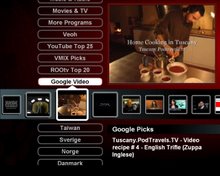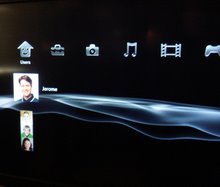The Issue: Apple TV unit volumes are lower than some had expected.
Background: Building a low-cost living room appliance which enables internet video access, remains a challenge. This continues to be the big obstacle preventing many companies expanding into living room video delivery.
Behind the scene: active-TV technology enables low-cost access to internet video in the living room, via enlisting behind-the-scenes support from a networked PC or laptop computer.
In a CNNMoneny.com article, Brent Schlender of Fortune argues that Apple TV is a “dud”. No unit shipment numbers are presented but the lack of promotional advertising is sited as indication of its unacceptability.
Listed as key weaknesses are:
- the requirement for an HDTV connection
- high price ($299)
- inability to order movies from the TV UI
- lack of DVD
- access to photos from only a single networked computer
A review of Apple-TV, comparing it with active-TV technology, in September 2006, entitled “Apple Takes the Extended-Path”, predicted many of the problems outlined by Schlender’s article. In view of these limitations, it can be assumed that Apple knew support for only widescreen high-def TVs would be limiting and their shipment numbers may consequently be inline with their initial expectations. What is needed to produce greater unit shipments, however, is a lower cost Apple TV and support for popular video - such as a YouTube channel.
Last week at the D conference, Steve Jobs announced that Apple TV would soon include support for YouTube viewing. It was stated that the TV UI will be “embedded into the AppleTV interface”. Also, TV access to YouTube “works off a live Internet connection that does not have to go through the PC”.
Apple TV’s ability to access YouTube video without the aid of a PC, is partly why the device is so expensive. Clearly the inclusion of a DVD player would make Apple TV more attractive, but this would add further cost to an already expensive appliance. I am sure Apple understands all the tradeoffs, but so far has chosen the more expensive path of a device with greater standalone capability.
A BusinessWeek article “What Apple TV costs to Make” by Arik Hesseldahl, estimates a bill-of-materials (BOM) of $237. This results in an untypical low profit margin for an Apple product. The Intel CPU and chipset are estimated at $68. Hesseldahl states “by typical Apple standards, the new set-top video box may as well be a hobby given how unprofitable it is in its current form”.
Long-term analyzers and developers of platforms bringing internet TV to the living room are familiar with the tradeoffs Apple TV faced. In short, it is difficult to build a reliable, low-maintenance and inexpensive box that that can enable flexible and polished access to internet video. Yes, the PC achieves this, but it has little acceptance as a device attached to the living room TV. Microsoft faced the same set of tradeoffs when it architected the Media Center Extender.
There is plenty of interesting video available from YouTube, Veoh, Vmix and many more. What the market needs is an acceptable low-cost hardware platform brining internet video to the living room TV. With over 100M shipments of Sony Playstation 2 (PS2) and a current price of about $130, BroadQ’s active-TV software for the PS2 is likely well positioned to challenge the market for DMA-styled devices – such as Apple TV. Fortunately, the PS2 also plays DVDs and games.
The active-TV technology approach results in very low additional cost at the TV side. This is particular true when active-TV technology is built directly into a networked TV. This is achieved by relying on a networked PC ‘invisibly’ doing all the “heavy lifting” work. The approach produces a different set of tradeoffs for the home user. For those that already own a networked PC or laptop computer, it is likely the least expensive way of bringing YouTube and other internet distributed video to the living room TV. Developers of traditional Set-Top Boxes, now working on enhancements such as network connectivity, or TVs with network connectivity, are using active-TV technology to enable internet video access with very little increase to the TV’s bill-of-materials.
The embedded Apple TV UI for YouTube will likely be of typical Apple quality. With active-TV technology it is easy for anyone to design and build their own YouTube TV interface. Active-TV technology developer MediaMall has recently updated its TV UI for YouTube. See image below.
Similar to early reports describing the Apple TV version, it uses IR remote Triple-Tap Entry to enter text strings when searching for new videos. This will likely be very popular. I also like the alternatively supported approach of selecting favorites from the YouTube PC UI, which then appear in the listings to the left of the screen. This can be done while using a wireless laptop PC in the living room along with a big screen TV showing the YouTube TV UI via active-TV technology support.
Apple TV problems such as the inability to access photos from more than a single networked computer are likely easily fixed. Existing active-TV alternatives already support this feature. The debate over what is appropriate for a TV UI (TV-web) and what should be left to the PC UI (PC-web) will continue, but I don't see keyboards making their way into living room for TV support. Apple is skilled at making these judgments, but the openness of active-TV technology allows anyone to offer their own solution, if they could just figure out what TV-UI users really want. Active-TV technology also works with standard-def or high-def Set-Top Boxes and TVs.
Feedback, corrections and comments welcome.
Daniel Mann











2 comments:
I have a iphone and ipood and I would like to have in one of them apple tv because I will be so excited and important to the life.
top free no deposit [url=http://www-casino.guru/]casino[/url] offers here !
Post a Comment